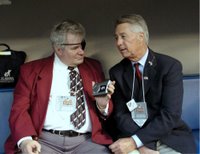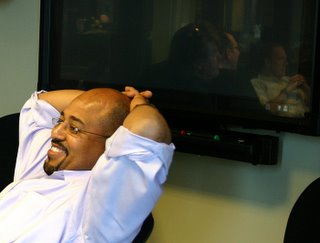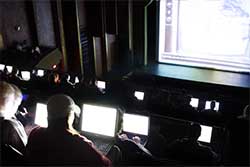After a two week hiatus I am back to blogging.
The New York Times reports that Broadband use is on the rise. No surprise. Right?
But did you know that it has more than doubled over the past three years?
The NYTimes says that a new Nielson/Net ratings study has found that " broadband use has exploded to 68 percent of web users today from 33 percent three years ago. " That's great news for those of us who work in rich media.
Stephenie Hollyman, a media versatile photographer and videojournalist presents this blog about multimedia content and tools for...video...photography & writing.
TO VIEW THIS BLOG USE FIREFOX OR SAFARI. INTERNET EXPLORER MAKES IT LOOK FUNKY, WITHOUT LINKS
Wednesday, March 29, 2006
Tuesday, March 14, 2006
Photo Editing Katrina
For those of us who work primarily as photographers, a talented photo editor can make or break our stories. Either we marvel at the spread of photos laid out on a newspaper or magazine or we cry bitter tears of disappointment. We then staple a picture of the the errant photo editor on a dart board.
Only joking.
Some say that photo editing is a highly intuitive art...a " talent thing" that can't be taught. Could be. Most definitely it IS a subjective process, no matter what anybody tells you.
This last September Kenny Irby, invited picture editors to offer some observations about Hurricane Katrina coverage. Here's what they said. Best Practices: Images of Disaster and How They Were Captured
A Flash plugin is required to play this show.
Only joking.
Some say that photo editing is a highly intuitive art...a " talent thing" that can't be taught. Could be. Most definitely it IS a subjective process, no matter what anybody tells you.
This last September Kenny Irby, invited picture editors to offer some observations about Hurricane Katrina coverage. Here's what they said. Best Practices: Images of Disaster and How They Were Captured
A Flash plugin is required to play this show.
Sunday, March 12, 2006
Digital Video Editing
There's nothing better than the spoken word combined with a visual demonstration to help us process information. Teachers in classrooms used chalkboards for a good reason. Now Powerpoint and white boards take their place.
In fact if you ever are trying to learn a new program by yourself go to one of my favorite sites www.Lynda.com and sign up for one month's unlimited usage of their spiffy Quicktime tutorials. It will set you back $20
but offer a wealth of information. I brushed up on my Final Cut Pro skills this way last Spring, before heading off to Africa and Cambodia to produce my cross-media project on malaria, Fever Zone. Seated on my couch with my laptop I played the Quicktime clips, pausing them to try the lessons for myself in real-time Final Cut mode. Sure beats reading a book.
http://www.webmonkey.com/webmonkey/02/15/index4a.html?tw=multimedia
Digital Video Editing
by Reno Marioni 24 Apr 2002
Reno Marioni lives in jolly ol' London as a technology and digital media consultant. In the past he's worked for Sun's Object Products group and Java-based startup Marimba. He also founded the Adventure Zone Network.
In fact if you ever are trying to learn a new program by yourself go to one of my favorite sites www.Lynda.com and sign up for one month's unlimited usage of their spiffy Quicktime tutorials. It will set you back $20
but offer a wealth of information. I brushed up on my Final Cut Pro skills this way last Spring, before heading off to Africa and Cambodia to produce my cross-media project on malaria, Fever Zone. Seated on my couch with my laptop I played the Quicktime clips, pausing them to try the lessons for myself in real-time Final Cut mode. Sure beats reading a book.
http://www.webmonkey.com/webmonkey/02/15/index4a.html?tw=multimedia
Digital Video Editing
by Reno Marioni 24 Apr 2002
Reno Marioni lives in jolly ol' London as a technology and digital media consultant. In the past he's worked for Sun's Object Products group and Java-based startup Marimba. He also founded the Adventure Zone Network.
Patrick's Shareware JavaScript Slideshow Generator
 Patrick Fitzgerald, the Code Bandito Who Generously Shares His JavaScript Slideshow Generator With You To Use
Patrick Fitzgerald, the Code Bandito Who Generously Shares His JavaScript Slideshow Generator With You To UseFor all of you ambitious code monkies out there here is a link that is worth its weight in gold, shareware in the very best sense of the word. With the slideshow wizard created by Patrick Fitzgerald you can now create a quick and easy JavaScript slideshow. In fact, in order to use this tool, you don't even have to know much at all. You just have to like to cut and past the URL's from where you store your images.
I use Flickr for now.
You may have seen the Flash slideshow Snow Struck Seaport I created for this blog,
 using code and the instructions from a fellow Blogger user. Now that the post is archived deep within Blogger the slideshow doesn't run. I also had problems re-sizing its player window and had to re-write some code on my Jogger template to fit the player.
using code and the instructions from a fellow Blogger user. Now that the post is archived deep within Blogger the slideshow doesn't run. I also had problems re-sizing its player window and had to re-write some code on my Jogger template to fit the player.Full Disclosure
I don't write code. I just cut and paste. Flash? I'd like to learn it but don't have time...or maybe even the apptitide to do so. I'm not very good with numerical concepts and have a terrible memory for anything that doesn't interest me. Like code. HTML? Fine. It's easy and WYSIWYG. And I go to always useful WebMonkey if my memory fails me while tagging.
Patrick Fitzgerald's Free JavaScript Slideshow Generator
That's why Patrick's shareware is so perfect for daffy story-teller folks like me.
I found this free tool while checking the source code for a slideshow on the site for the Side Photograhic Gallery home page which I saw while researching my previous post on Weegee. I tried playing it with various browsers and it does just fine. Check it out yourself.
Go to BarelyFitz Design's JavaScript Slideshow wizard and play around. If you don't get it, Patrick has even been nice enough to do a demo where he shows you how to do it. Patrick's Slideshow Demo includes his voice.
Thanks Patrick! When I get some time this non-techie will play around with your useful wizard. Although he doesn't charge for usage of this code, Patrick Fitzgerald does accept donations. Since 1994, Patrick Fitzgerald has created and maintained sites for diverse clients — from Fortune 100 corporations to non-profit organizations.
Saturday, March 11, 2006
Blindly Covering Baseball

Photo Courtesy www.athomeplate.com
Stuck on the subway today I flipped through the pages of The New York Post. You never know what you'll find. There below a photo captioned " Kiss That Baby Hello!" I read about radio baseball reporter Ed Lucas, 67, getting married. He's legally blind.
Equipped with an inner sense for baseball, www.athomeplate.com says Lucas "does not do the play by play although he does have the uncanny ability to determine where a hit ball will go just by the sound it makes coming off of the bat
Pretty amazing, wouldn't you say? We all have our stories to tell and figure out how to use the right media to do so.
You may be asking yourself how does a blind man report on baseball games. Ed hasn’t always been blind. Even though he was born with a congenital eye disease he was able to see. He had a love of baseball from a very young age, as both of his parents were fans of the Giants – that is the NY Giants, prior to their move west. As a matter of fact the last game that Ed saw was the 1951 thriller in which Bobby Thomson hit the “shot heard ‘round the world”.
He was twelve years old. He came home from school and watched it on TV with his family. After the game he went outside to play baseball in the nearby sandlot and was hit between the eyes with a baseball. Shortly afterwards, he lost his sight – partially due to the eye disease that he was born with, although doctors believe that being hit in the head with a baseball may have also contributed in the loss.
So, how does he do it? He does not do the play by play although he does have the uncanny ability to determine where a hit ball will go just by the sound it makes coming off of the bat. Ed’s method is this – he sits in the press box and listens to the local radio broadcast of the game. Then after the game he goes to the field or the locker room or press area and interviews players about what happened during the game – perhaps an extraordinary play or call or any incident that may have been out of the ordinary. He adds his notes to the tape and sends it in to someone that types and submits it for him. He has had articles published in many newspapers and magazines.
www.athomeplate.com
Yesterday Yankee Stadium become the wedding chapel for Lucas and his bride, 51-year-old Allison Pheifle, a major baseball fan who is also legally blind. Yankee legend Phil Rizzuto introduced the two several years back.
Congratulations.
Totally Submersive IMAX Big Screen Experience

Photo Courtesy www.boingboing.net
IMAX beckons us to head out to our nearest large screen theater to enjoy their latest 3D extravaganza, IMAX Deep Sea 3D, which Imax co-CEO Brad Wechsler says is
" giving the consumer a reason to get off the couch." On the same web page a Netflix ad tells us that we can enjoy movies in our home. What's a person to do with so many choices at hand?
Are you asking ME? If so I would say, take a look at this trailer and then head for the nearest IMAX theater with your favorite squeeze. Put on your cool sexy 3D shades and go retro like bloggers at Boing Boing did. Movies at home are for rainy nights and take-out Chinese food. Nothing rivals the Big Screen for the ulimate sensory experience.

View the IMAX Deep Sea 3D Trailer with Quicktime 7
Spin through the deep with your small screen for now, watching the IMAX Deep Sea Trailer here after downloading the Quicktime 7 player for Mac or Quicktime 7 player for Windows free. Let the ocean's surf sweep onto your screen while your fingers stay dry on your keyboard.
This truly immersive and submersive movie experience was shot with the world's largest camera, weighing in at 1,300 pounds in its underwater housing. Big Bertha, billed by Deep Sea 3D director Howard Hall as " almost totally impractical," needs two people for its operation and costs $60 a second to use.
No small screens here, as in Little Screens, Little People,my previous post. Nestle together with your friends and listen to the stirring surround-sound musicial score. Hear Johnny Depp and Kate Winslet narrate this ode to the marvels of Big Blue life down under. Feel yourself flinch with real fear ...into your date's arms... while jelly fish seems to swim one foot away from your popcorn.
Feel your spirit and soul soar as you float through current and tide with turtles, little and BIG fishies, manta rays... just a few of the many deep-sea denizens that share this planet with us. But if you don't believe me, read all about it at Wired or www.boingboing.net.

Photo Copyright Arthur Felig
Remember Weegee's pix of people that watching the first 3D flix in the 50's? Weegee, my hero, worked out of the trunk of his car which he used as darkroom through the 30's and 40's when he invented a whole new genre for photojournalists. Take a look at images taken in movie theaters, he shot using infrared film, from an ICP exhibition now online, Weegee's World: Movie Goers.
Stay tuned for more on Weegee at a later date.
Monday, March 06, 2006
Little Screens, Little People?
 Photo Copyright Dennis Chamberlin
Photo Copyright Dennis ChamberlinViewer as Victim?
Last night we heard many times Oscar recipients talking about the impact that viewing a film on the " big screen" can have. And indeed for this movie maven, films projected on the big screen have always been the greatest escape. But now, with small screens so pervasive, "technology can transport us so far, and so fast," writes Jessica Helfand in her book Essays on Graphic Design, New Media, and Visual Culture. Indeed it is almost " scary to think of the viewer as victim," as the
" precipice between believability and brainwashing grows narrower by the second. "
 Photo Copyright Dennis Chamberlin
Photo Copyright Dennis ChamberlinThe more we grow accustomed--indeed addicted--to the screens around us, whether in the form of television, computer, film, or a combination thereof, the more we imprison our minds and restrict out capacity to exercise thoughtful independent judgment.
Jessica Helfand,
Essays on Graphic Design, New Media, and Visual Culture
In the previous post Smart Mobbers' Endangered Digits I wrote about Smart Mobbers who communicate using text messaging.
Photographer Dennis Chamberlin's " Screen Culture"
Shortly after reading Helfand's essays I stumbled across Dennis Chamberlin's photo essay, " Screen Culture" of people interacting with screens, what he calls their " new reality". I found Chamberlin's work displayed at www.sitewelder.com a web site provider for photographers where we both host our sites. I contacted Chamberlin and requested permission to include a few of his images on this blog. He kindly complied and also included his personal statement.
Dennis is now an assistant professor at the Greenlee School of Journalism and Communication at Iowa State University. A contract photographer with the New York Agency, Black Star from 1989-2005, he worked as a freelance photojournalist based in Poland from 1987-2002. His clients have included National Geographic,
The Economist, Forbes, GEO, Liberation, Newsweek, TIME Magazine, New York Times Magazine,
US News & World Report, PepsiCo. International, Procter&Gamble, and International Paper.
Screen Culture: Photographer's Statement
Over the years we have incorporated technology into to our world to such a degree that we no longer notice the role it plays in our daily lives. Televisions, and in a much broader sense video screens, have a ubiquitous presence in American culture. The technology involved, whether high definition television or portable video games, is purported to increase communication between individuals and allow for greater dissemination of information, but in practice these technologies have isolated us from one another. I have seen this phenomenon while making the images for this project, whether it is with adults lost in the world of a favorite television program or my own children entranced by a blinking object on a computer screen.
Photo Copyright Dennis Chamberlin
My approach toward the project is in the tradition of straight documentary, and the photographs are the result of observing the subjects as they become engaged with the media in front of them. We all spend a part of our day staring at screens, sometimes while at work, or perhaps as a way to relax at the end of the day, and I think that most of us can see ourselves somewhere in these photos.
We tried an experiment for one year in our home: to live without television or video games. After a couple of months of this self-imposed exile from popular culture, we bought a computer with the capability of viewing DVD movies on its 17"” screen. This was sufficient for the first year. After a year our 11 year-old son bought a used Gameboy on the internet. One day, a couple of months later, he sold the first model to his younger siblings and used the money to buy a better Gameboy purchased from a friend who had recently received an even newer model. Then came the used television, received as a gift from a relative. A television without a DVD/VCR combo player isn'’t of much use so that was the next acquisition. Our home is now pretty well outfitted for the moment, but we are still lacking a plasma screen as well as camera phones. We used to talk with one another. Now we stare at screens.
Dennis Chamberlin
Wednesday, March 01, 2006
Netizen Kenny Irby Speaks
 Kenny Irby, Director of the Visual Journalism Group at The Poynter Instutue. Photo Ben Russell/NewsU
Kenny Irby, Director of the Visual Journalism Group at The Poynter Instutue. Photo Ben Russell/NewsU This is the second query of what will beome a regular feature of this blog. Called "Netizens Speak" I queried Kenneth F. Irby, Visual Journalism Group Leader & Director of Diversity Programs at The Poynter Institute For Media Studies last night, asking, "How do you think people process audio content vs visual? What is power or strength of one over the other?" Eloquent as ever, Kenny just replied.
For me, I think that the web affords media companies a tremendous opportunity to enrich reporting and information delivery. Information consumers now have far more options than every before and journalists must meet these needs to remain competitive in this new age media consumption. Audio is the new hot things for print outlets. Albeit, it is not new really new--- radio has been around for a long time. The authenticity and emotional factors are increased by blending natural sound with still photographs. People are attracted by quality integration of audio and photojournalism. Both audio and still photography are powerful story telling structures, together they are extremely powerful and effective journalistic tools. The combination of a compelling photograph complimented by the natural voice of the individual explaining the context of their situation is arresting.
-Kenny Irby, The Poynter Institute
Subscribe to:
Comments (Atom)
